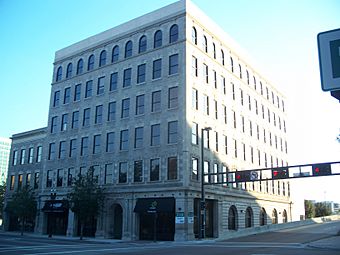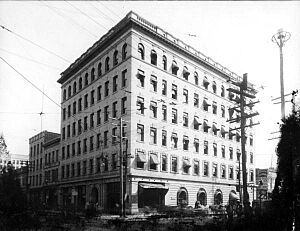Dyal–Upchurch Building facts for kids
Quick facts for kids |
|
|
Dyal–Upchurch Building
|
|
 |
|
| Location | Jacksonville, Florida, USA |
|---|---|
| Area | 43,747 ft |
| Architect | Henry John Klutho |
| Architectural style | Chicago school |
| NRHP reference No. | 80000947 |
| Added to NRHP | April 17, 1980 |
The Dyal–Upchurch Building is a historic six-story building in Jacksonville, Florida. It is also known as the Dyal–Upchurch Investment Company Building. This important building is located at 4 East Bay Street. It was designed by the famous architect Henry John Klutho. On April 17, 1980, the building was added to the U.S. National Register of Historic Places. This means it is recognized as a special place in history.
Contents
Building History and Design
The city of Jacksonville had a huge fire in 1901. It was called the Great Fire of 1901. After this fire, the downtown area was mostly empty. The Dyal–Upchurch Building was the first tall building constructed there. It was also the first building in Jacksonville designed by Henry John Klutho.
Construction started with plans for a five-story building. But there was a big need for office space. So, a sixth floor was quickly added to the plans.
Who Were Dyal and Upchurch?
The building is named after Dyal–Upchurch. This was an investment company from Georgia. They moved to Jacksonville after the big fire. Frank Upchurch was involved in the turpentine and lumber businesses. Benjamin Dyal owned a sawmill. The company stopped doing business in Jacksonville after 1924.
Early Tenants and Use
The Atlantic National Bank opened shortly after the building in May 1902. Their first office was on the ground floor. They stayed there until their own building was finished in 1909.
Many other businesses have used the Dyal–Upchurch Building. These include an office for the National Weather Service. There was also a regional office for an insurance company. Law offices and financial advice companies have also been tenants.
Restoration and Ownership Changes
In 1980, the building was added to the National Register of Historic Places. This made it possible to get special tax credits. These credits helped pay for restoration work done in 1981. It was the first building in Jacksonville to use these special credits.
In 1998, an advertising company called Husk Jennings bought the building. They paid $1.6 million for it. They spent another $600,000 to fix up the top floor. Their company then moved into that renovated space.
In May 2002, the city created a special fund. It was called the Downtown Historic Preservation and Revitalization Trust Fund. This fund had $7 million to help companies. It helped them buy and restore old buildings. The fund could pay for up to half of the outside work. It could also pay for one-fifth of the inside work. There was a limit of $1 million per building.
This fund encouraged Husk Jennings to start a bigger restoration. They spent $1.72 million to restore the rest of the building. The city helped by paying almost $340,000 of that cost.
In December 2005, a developer named Cameron Kuhn bought the building. He paid $4.5 million for it. However, his company went bankrupt in 2008. This meant he could not pay his mortgage. The Jacksonville Bank took back the Dyal–Upchurch building in January 2009. On February 28, 2009, it was sold for $3.73 million. A company called A. Duda & Sons bought it.
Tallest Building Records
| Records | ||
|---|---|---|
| Preceded by Unknown |
Tallest building in Jacksonville 1902–1909 25m |
Succeeded by 121 Atlantic Place |
| Preceded by Unknown |
Tallest building in Florida 1902–1909 25m |
Succeeded by 121 Atlantic Place |
See also
 In Spanish: Dyal-Upchurch Building para niños
In Spanish: Dyal-Upchurch Building para niños




